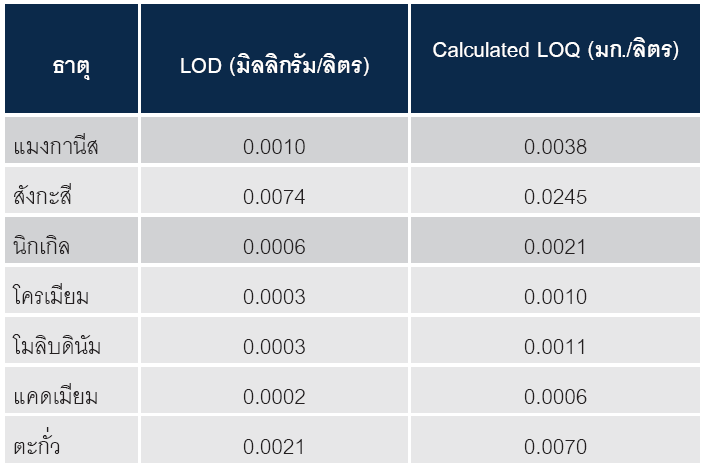Method validation for determination of manganese, zinc, nickel, chromium,molybdenum, cadmium and lead released from aluminium cooking utensils
DOI:
https://doi.org/10.60136/bas.v12.2023.402Keywords:
Aluminium cooking utensils, Food contact materials, Release elementAbstract
Aluminium cooking utensils are widely used in Thailand and other ASEAN countries due to their lightweight, transferring heat quickly and cheap prices. There is a trade-off, however, because almost all aluminium cooking utensils can release metals through food when they contact with acidic foodstuffs. The method for determination of manganese, zinc, nickel, chromium, molybdenum, cadmium and lead released from aluminium cooking utensils by inductively coupled plasma optical emission spectrometry (ICP-OES) was validated according to Metals and alloys used in food contact materials and article. A practical guide for manufactures and regulators [1].Results showed that instrument working ranges of manganese, nickel, chromium, molybdenum, cadmium and lead were 0.05 - 1.0 mg/L and zinc was 0.10 - 1.0 mg/L. The limit of detections of manganese, zinc, nickel, chromium, molybdenum, cadmium and lead were 1.0, 7.4, 0.6, 0.3, 0.3, 0.2 and 2.1 µg/L. The limit of quantitations of zinc was 0.10 mg/L and the others were 0.05 mg/L. The bias and precision studies showed that percentage of recovery and relative standard deviations of seven elements were 83.8 - 98.4 and 1.17 - 4.17, respectively. While the expanded uncertainties of all elements were less than ± 15 %, at the confidence level of 95%. Therefore, this test method for determination of seven released elements from aluminium cooking utensils by ICP-OES is valid and fits for intended use.
References
The Committee of Experts on Packaging Materials for Food and Pharmaceutical Products (P-SC-EMB), European Directorate for the Quality of Medicines & HealthCare. Metals and alloys used in food contact materials and article: A practical guide for manufactures and regulators. Strasbourg: Council of Europe; 2013.
The European Parliament and The Council of the European Union. REGULATION (EC) No 1935/2004 of the European Parliament and of the council of 27 October 2004 on materials and articles intended to come into contact with food and repealing Directives 80/590/EEC and 89/109/EEC [Internet]. 2004 [cited 2022 Dec 20]. Available from: https://eur-lex.europa.eu/LexUriServ/LexUriServ.do?uri=OJ:L:2004:338:0004:0017:en:PDF
Eurachem Method Validation Working Group. Eurachem guide the fitness for purpose of analytical methods- A laboratory guide to method validation and related topics. 2nd ed. Belgium: Eurachem Secretary; 2014.
Barwick VJ, Ellison SLR. VAM Project 3.2.1 development and harmonisation of measurement uncertainty principles part (d): Protocol for uncertainty evaluation from validation data version 5.1 [Internet]. Teddington(UK): LGC (Teddington) Limited; 2000 [cited 2022 Dec 20]. Available from: http://www.demarcheiso17025.com/private/Protocol%20for%20uncertainty%20evaluation%20from%20validation%20data.pdf
ศศิธร หอมดำรงวงศ์, จตุรงค์ สินแก้ว, อุมา บริบูรณ์. การวิเคราะห์ตะกั่ว แคดเมี่ยม และอะลูมิเนียมที่ละลายออกมาจากภาชนะหุงต้ม. วารสารกรมวิทยาศาสตร์การแพทย์. 2558;57:37-47.
Sander S, Kappenstein O, Ebner I, Fritsch K-A, Schmidt R, Pfaff K, et al. Release of aluminium and thallium ions from uncoated food contact materials made of aluminium alloys into food and food simulant. PLoS ONE [Internet]. 2018 [cited 2022 Dec 20];13:1- 15. Available from: https://doi.org/10.1371/journal.pone.0200778
Stahl T, Falk S, Rohrbeck A, Georgii S, Herzog C, Wiegand A, et al. Migration of aluminum from food contact materials to food – a health risk for consumers? Part III of III: migration of aluminum to food from camping dishes and utensils made of aluminum. Environ Sci Eur. 2017;29:17. doi:10.1186/s12302-017-0117-x.

Downloads
Published
How to Cite
Issue
Section
License
Copyright (c) 2023 Bulletin of Applied Sciences

This work is licensed under a Creative Commons Attribution-NonCommercial-NoDerivatives 4.0 International License.









